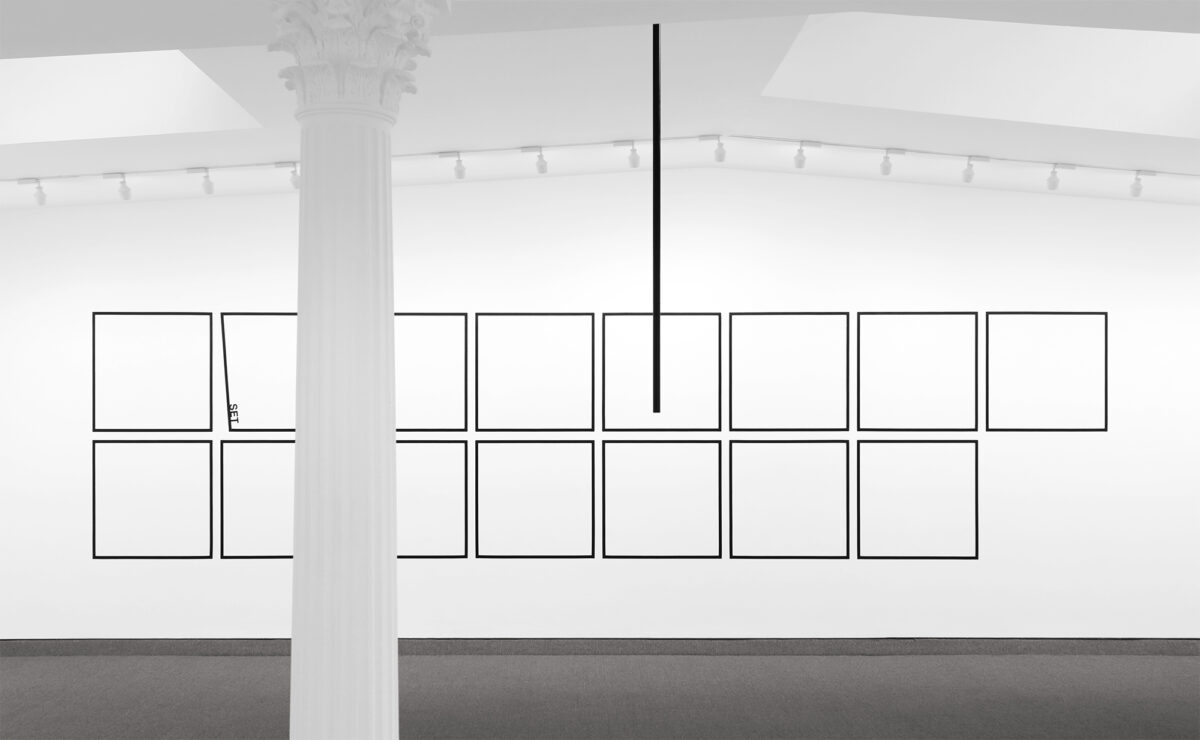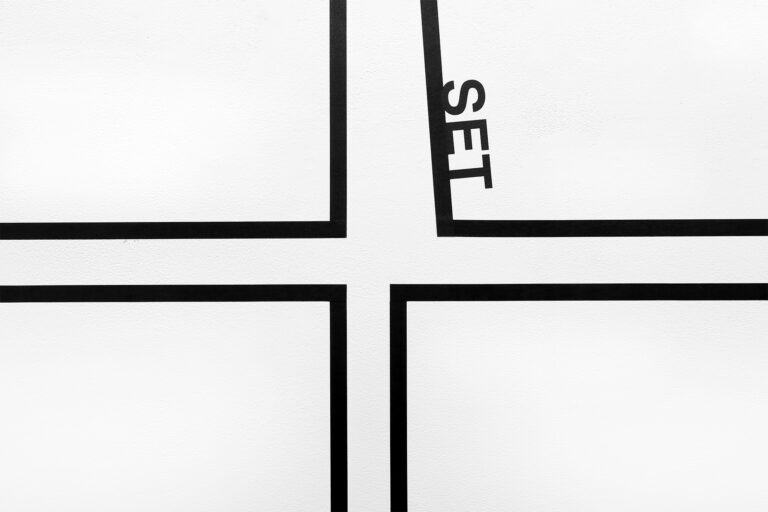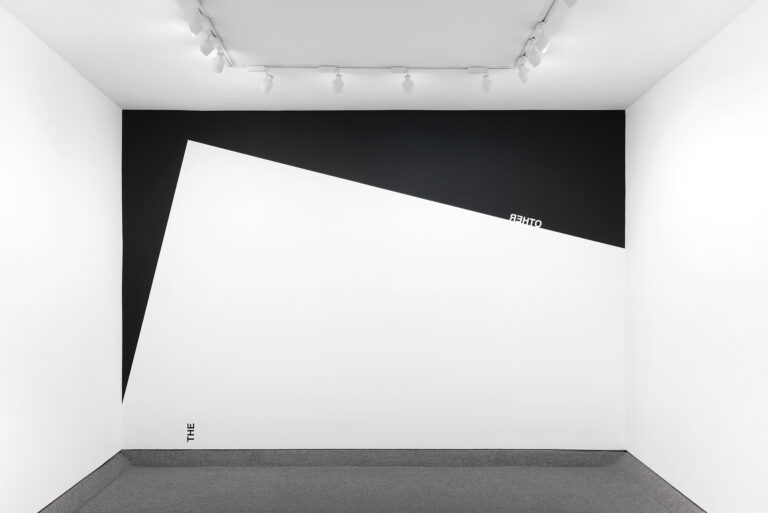
“Downsbrough’s works are markers that define the intersections between the conditions and experience of their construction and perception. Rather than describing a situation, they concretize, fragment, and intervene in the process and conditions of representation. They do not delineate a place but the conditions of place.”
—Ann Goldstein, in “Reconsidering the Object of Art, 1965–1975”
Downsbrough’s pieces (he often calls them interventions) engage their surroundings and create situations of extraordinarily elegant multiplicity. Lines and shapes are altered, referenced, and/or repeated. No one viewpoint provides the full experience. Every addition/gesture/intervention of Downsbrough’s heightens one’s awareness of the space, the objects, one’s own location, and the interactions between all.
A significant part of the formal arrangements are letters, which are traditionally read as words. For Downsbrough, the letters are arranged to be read as words and to be viewed as formal elements that ‘work’. Whether a word illustrates what it is that it says or less directly references relationships to a form in its vicinity, the word becomes an active participant in a viewer’s experience. Normally words ‘work’ for a reader to help one understand information simply by being read. Downsbrough is respectful of this function, but adds to it by having the words demonstrate or converse with the meaning of the words. In several instances, the words are in mirror image. When this happens, the words are short enough to be rather easily read, but in order to do this, a viewer adjusts their way of thinking in order to decipher the letters. In one way of thinking, one has to imagine being on the other side of the letters to read them and so, once again, Downsbrough’s work emphasizes resituating oneself, being willing to take another viewpoint, and the importance of engaging in an (w)holistic approach that offers a multitude of new observations.
In 1959, Peter Downsbrough interrupted his studies in architecture to work as a sculptor. He had his first show in New York in 1961 and by the mid-1970’s, gained international recognition. Throughout the 1970’s and 1980’s, he was consistently invited to participate in exhibitions throughout Europe and so, in 1989, he relocated to Brussels, Belgium. He has continued to show internationally at places such as MoMA, New York, MoCA, Los Angeles, S.M.A.K., Gent, Belgium, Muzeum Sztuki, Lodz, Poland , FRAC Bourgogne, Dijon, France, MAMCO, Genève, Switzerland, Musée St Pierre d’Art Contemporain, Lyon, Center for Contemporary Art Ujazdowski Castle, Warsaw, Poland, Maison Levanneur, Centre national de l’estampe et de l’art imprimé, Chatou, Van Abbemuseum, Eindhoven, P.S.1, Long Island City, New York, Paleis voor Schone Kunsten/ Palais des Beaux-Arts, Brussels, Musée Régional d’art contemporain Languedoc-Roussillon, Sérignan, Mies van der Rohe Pavilion, Barcelona, Mac’s, Musée des Arts Contemporains, Grand-Hornu, The Renaissance Society, Chicago, Openluchtmuseum voor Beeldhouwkunst Middelheim, Antwerpen, and the Architectural Gallery, Moscow, Russia. In addition, he has had numerous film screenings at institutions such as the Centre Pompidou, the Reina Sofia and the Kunsthalle Bern, among others.

Installation dimensions are variable, this installation is 96 x 128 inches (243.8 x 325.1 cm)
Signed and dated on accompanying certificate
(Inventory #35654)
Installation dimensions are variable, this installation is 96 x 128 inches (243.8 x 325.1 cm)
Signed and dated on accompanying certificate
(Inventory #35654)

Installation dimensions are variable, this installation is 130 1/2 x 494 1/2 inches (331.5 x 1256 cm)
Signed and dated on accompanying certificate
(Inventory #35653)
Installation dimensions are variable, this installation is 130 1/2 x 494 1/2 inches (331.5 x 1256 cm)
Signed and dated on accompanying certificate
(Inventory #35653)

Installation dimensions are variable, this installation is 91 1/2 x 137 inches (232.4 x 348 cm)
Signed and dated on accompanying certificate
(Inventory #35655)
Installation dimensions are variable, this installation is 91 1/2 x 137 inches (232.4 x 348 cm)
Signed and dated on accompanying certificate
(Inventory #35655)


Paper size: 3 15/16 x 9 inches (10 x 23 cm)
Frame size: 7 1/4 x 12 1/4 inches (18.4 x 31.1 cm)
Initialed “P.D.” and dated “5.20” verso
(Inventory #35619)
Paper size: 3 15/16 x 9 inches (10 x 23 cm)
Frame size: 7 1/4 x 12 1/4 inches (18.4 x 31.1 cm)
Initialed “P.D.” and dated “5.20” verso
(Inventory #35619)


Installation dimensions are variable, pipes are all 3/4 inch diameter and lengths are 25 5/8 inches (65 cm), 31 1/2 inches (80 cm), and 59 inches (150 cm)
Signed and dated on accompanying certificate
(Inventory #35625)
Installation dimensions are variable, pipes are all 3/4 inch diameter and lengths are 25 5/8 inches (65 cm), 31 1/2 inches (80 cm), and 59 inches (150 cm)
Signed and dated on accompanying certificate
(Inventory #35625)


Edition of 100
Installation dimensions are variable
Unsigned and unnumbered
(Inventory #36060)
Edition of 100
Installation dimensions are variable
Unsigned and unnumbered
(Inventory #36060)

No results found.
10 Newbury Street, Boston, Massachusetts 02116
617-262-4490 | info@krakowwitkingallery.com
The gallery is free and open to the public Tuesday – Saturday, 10am – 5:30pm